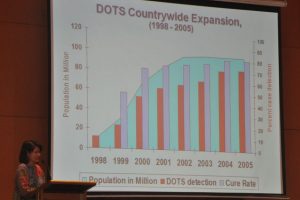NEWS AND UPDATES
Country’s TB program strategy, targets the attainment of the MDGs

“The increase in prevalence of tuberculosis has been due to the low priority accorded to anti-tuberculosis activities by many countries. The unavailability of anti-TB drugs, insufficient laboratory networking, poor health infrastructures, as well as a lack of trained health personnel, have also contributed to the rise in the incidence of the diseases,†according to Dr. Rosalind G. Vianzon, National TB Program (NTP) Manager from the National Center for Disease Prevention and Control (NCDPC) of the Department of Health (DOH).
The NTP is the government’s commitment to address the TB problem in the country and its main strategy is to use the Directly-Observed Treatment Short-course (DOTS) to detect and cure TB patients.
Significant progress was recorded since the Philippines adopted the DOTS strategy in 1996. At the end of 2002-2003, all public health centers were able to deliver DOTS services.
In 2007, the treatment success of TB was able to reach above 85% and is expected to be sustained in the next years. The cure rate was posted at 82% in 2007 but it is likely to increase at 85% by 2015.
The case detection rate for new smear positives has reached the international target of 70% as early as 2004 and has been sustained up to the present.
Dr. Vianzon reported that the case detection rate of all forms of TB seemed to be weak and mostly reaching below 70%. That is why the call to increase case detection to 70% or at least 85% is deemed necessary.
“We are not just looking on all new forms of TB but merely considering all forms because epidemiologically, you cannot control a program if you will focus only on the highly infectious,†she said.
Dr. Vianzon mentioned that there are two key documents on TB research. One is the Philippine Plan of Action to Control TB (PhilPACT) 2012-2016 and the other is 2010 Tuberculosis Research Priority Agenda Setting.
The PhilPACT is the roadmap of the NTP and attuned with the health sector reform “Kalusugan Pangkalahatan†or KP. It is in line with TB global plans such as The Global Plan to Stop TB 2011-2015, Stop TB Partnership (technical arm of the international communities on TB control) and Regional Strategic Plan of Western Pacific.
The 2010 Tuberculosis Research Priority Agenda Setting meanwhile, is the research monograph of the NTP and was developed to support the R&D of NTP. This monograph was based on the 8-point strategy of NTP plan, with perspectives coming from both public and private sectors. The document was intended for doers, funders and implementers of research.
The 2010 Tuberculosis Research Priority Agenda Setting is published through a funding from the Philippine Council for Health Research and Development of the Department of Science and Technology (PCHRD-DOST).




